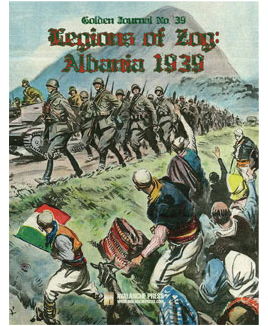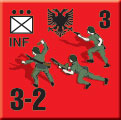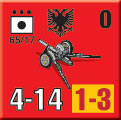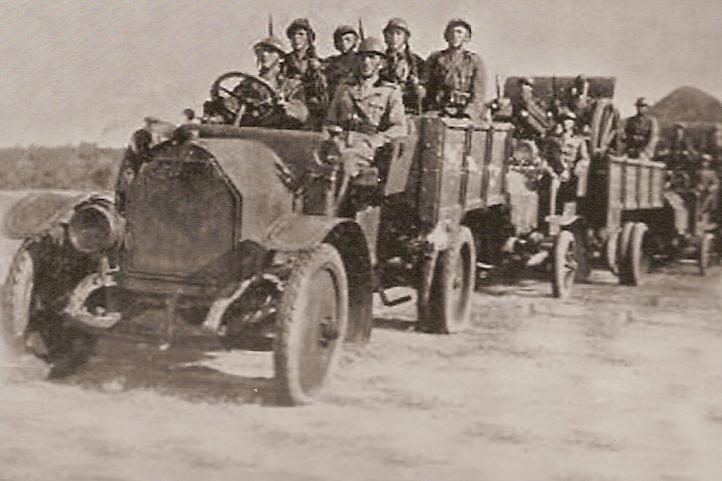| Golden Journal No. 39:
Legions of Zog
The Army of Zog
by Mike Bennighof, Ph.D.
March 2022
 In September 1928, Albanian President Ahmet Zogu declared his country a constitutional monarchy and himself its monarch as King Zog I. He also named himself Field Marshal of the Royal Albanian Army, and proceeded to rule for the next decade more as a military dictator than as a monarch. In September 1928, Albanian President Ahmet Zogu declared his country a constitutional monarchy and himself its monarch as King Zog I. He also named himself Field Marshal of the Royal Albanian Army, and proceeded to rule for the next decade more as a military dictator than as a monarch.
Despite Zog’s attempts to break free, Italian influence only increased during his reign. The Royal Albanian Army, such as it was, depended on Italian arms, Italian trainers and even Italian officers. Zog survived over 600 blood feuds and at least 55 assassination attempts, but when Queen Geraldine bore him an heir, Benito Mussolini decided to convert Albania from client state to conquest before a dynasty could be established. Italian troops swarmed over the country, and Zog had little means to resist.
The Royal Albanian Army had been officially declared when Zog took the throne, with himself as its first and only Field Marshal. By April 1939 it consisted of 15,000 men on paper, with probably about half that many actually under the colors when the Italians invaded.
The Infantry

Seven infantry battalions made up most of the Royal Army’s strength; plans to stand up two more had gone nowhere. Each had a territorial recruiting district, but conscription had not been enforced in large segments of the country so three of the seven battalions drew their manpower from Tirana, the capital. Battalions were not numbered; each was named for a mountain: Daijti, Deja, Gramos, Kaptina, Korata, Tarabosh and Tomori. After the conquest the Tomori and Tarabosh Battalions would be revived by the Italian MVSN as Blackshirt outfits.
In Albanian service, an infantry battalion had three infantry companies and one machine-gun company. Each infantry company in turn had three platoons, or togë, led by a lieutenant, or togër assisted by a sergeant, or nentogër. A platoon had 35 men split into three squads of 11 men each, all armed with rifles. Albanian infantry platoons did not include an organic machine gun.
Machine guns instead were kept at the battalion level, in a company of three platoons, each of those having four Austrian-made Schwarzlose weapons (from Italian stocks of war booty) or Italian-made Fiat guns. Italian advisors sabotaged many Albanian heavy weapons just before the invasion, so it’s unclear how many of these would have been available to resist.
Other than the three battalions (Deja, Daijti and Korata) placed to defend the capital from angry tribesmen, Albanian battalions in April 1939 were still at their peacetime establishment, with two infantry companies at full strength and the third plus the machine-gunners only at cadre levels.
In addition to the Royal Infantry, Albania also disposed of four battalions of Frontier Guards, each of three companies of four platoons each but no machine-gunners. Zog kept the Frontier Guard at pretty close to its paper strength, thanks to their role in collecting desperately-needed customs revenue. The Italians kept them on after the conquest, incorporating them into the Guardia di Finanza.
Albania’s fleet of two patrol boats (former Imperial German coastal minesweepers) had been damaged in a 1935 uprising and never repaired. Their guns were removed in 1939 and emplaced in a coastal battery; their crews remained on the payroll and formed a small platoon of naval infantry that fought at Durrës in April 1939.
Albanian infantrymen (including gendarmes and Frontier Guards) carried the standard Italian bolt-action service rifle, the 6.5mm Carcano M1891. To make up for the lack of a light machine gun in the infantry squads, in theory one squad of each platoon was to wield Beretta Model 1918 or Model 1938 submachine guns.
Additional Austrian-made Mannlicher M95 straight-pull rifles plus another 10,000 to 15,000 M1891 weapons were held in depots; these were to be issued in time of war but Zog did not dare arm his populace. Ammunition was in limited supply as well.

Zog’s Royal Guard Battalion had four companies rather than the usual three.
About 8,000 men were enrolled in a volunteer reserve force known as the Kreshnikë (“berserkers”); Zog did not call them to the colors in April 1939 beyond his final radio broadcast urging all Albanians to fight to the last drop of blood (issued just before the fled the country). Theoretically they would have drawn arms from the Royal Army’s depots, but these were never issued.
Beyond those forces, roughly 25,000 tribal militia in theory could be called to supplement the regular forces. Zog had ordered these men disarmed, and though many had ignored the order the lack of weapons hampered the response to the Italian invasion; only Zog’s Mehti tribe offered much resistance to the invaders. On the other hand, the lack of weapons had also helped keep Zog on the throne until 1939 and greatly reduced clan feuding and local banditry, so a trade-off was involved.
The Gendarmerie
Zog feared a military coup (along with assassination, tribal uprisings and foreign invasion), and looked to the national militarized police, the Gendarmerie, as a potential counter to the Royal Army. Therefore, the gendarmes were trained and advised by British officers (usually retired veterans of the British Indian Army) rather than Italians. Like the Frontier Guards they boasted a great deal of low-intensity conflict experience dealing with the constant clan feuds and tribal wars outside Albania’s small urban areas. In April 1939 they resisted the Italians much more energetically than did the Royal Army.
The Gendarmerie numbered six battalions in April 1939, with a varying number of companies (depending on their policing requirements) and just one machine-gun platoon. They fought much harder than the Royal Army in April 1939, but in a campaign lasting but one day that’s a relative measurement.
The Royal Artillery

The paper strength of the Royal Army included two batteries each of Italian-supplied 149mm and 105mm howitzers. None of these weapons were ever actually delivered (though some sources list them as available). Instead, the Albanian artillery relied on the ubiquitous Italian Model 1913 65mm mountain gun. Eight of nine planned batteries had been equipped by April 1939. Four more batteries used the Austrian-made Skoda L/13 75mm mountain gun, weapons delivered from Italian stocks of captured weapons, with one additional battery with this gun assigned to the Gendarmerie, Royal Guard and Frontier Guard (each).
Albanian mountain gun batteries – all of them named for rivers, rather than numbered –
had just two guns apiece, so the playing piece represents two of them. The two batteries of 75mm Krupp Model 1906 field guns, however, had four tubes apiece and appear to have been motorized:

An Albanian motorized artillery battery.
During the invasion the most effective Albanian guns were the four 75mm naval pieces removed from patrol boats just before the war and installed as a coastal battery overlooking the port at Durrës. Italian engineers had built modern casemate mounts for them; Italian preparation for the invasion apparently had its limits.
The Royal Tank Squadron

In 1935 the Albanians purchased six CV33 Ansaldo-made tankettes; some years earlier they had acquired two Fiat 3000B tanks. The small armored unit depended heavily on its Italian instructors and mechanics; it was not deployed against the invaders and its Italian overseers took custody of the vehicles, which were then taken by the invaders and re-issued to Italian units.
The CV33 had the virtue of a low price, one subsidized by the Italian government in its quest for hard currency, and few other virtues. The Italians would use them with mixed success in the rough terrain of Ethiopia and later during the 1940 invasion of Greece launched from Albanian territory. The handful of tanks might therefore have been of some use to the Albanians, but they had more dire needs for their limited cash reserves.
Albania also had eight elderly Italian-made armored cars, but these seem to have broken down and been taken out of service by the time of the invasion. Albania had no cavalry branch (the one cavalry squadron was part of the Royal Guard) and the Royal Tank Squadron was actually part of the transportation branch. Albania had no motorized troops in 1939 beyond the two artillery batteries, despite what some sources claim, but the Royal Army did have enough trucks to lift several companies at once had the will to do so existed.
And those are the Legions of Zog.
The Golden Journal is only available to the Gold Club (that’s why we call it the Golden Journal). If you want your Albanians, you need to join now.
Click here to join the Gold Club.
See your Gold Club Insider newsletter for ordering information.
Sign up for our newsletter right here. Your info will never be sold or transferred; we'll just use it to update you on new games and new offers.
Mike Bennighof is president of Avalanche Press and holds a doctorate in history from Emory University. A Fulbright Scholar and NASA Journalist in Space finalist, he has published a great many books, games and articles on historical subjects.
He lives in Birmingham, Alabama with his wife, three children, and his dog Leopold, who is a good dog.
Want to keep Daily Content free of third-party ads? You can send us some love (and cash) through this link right here.
|
